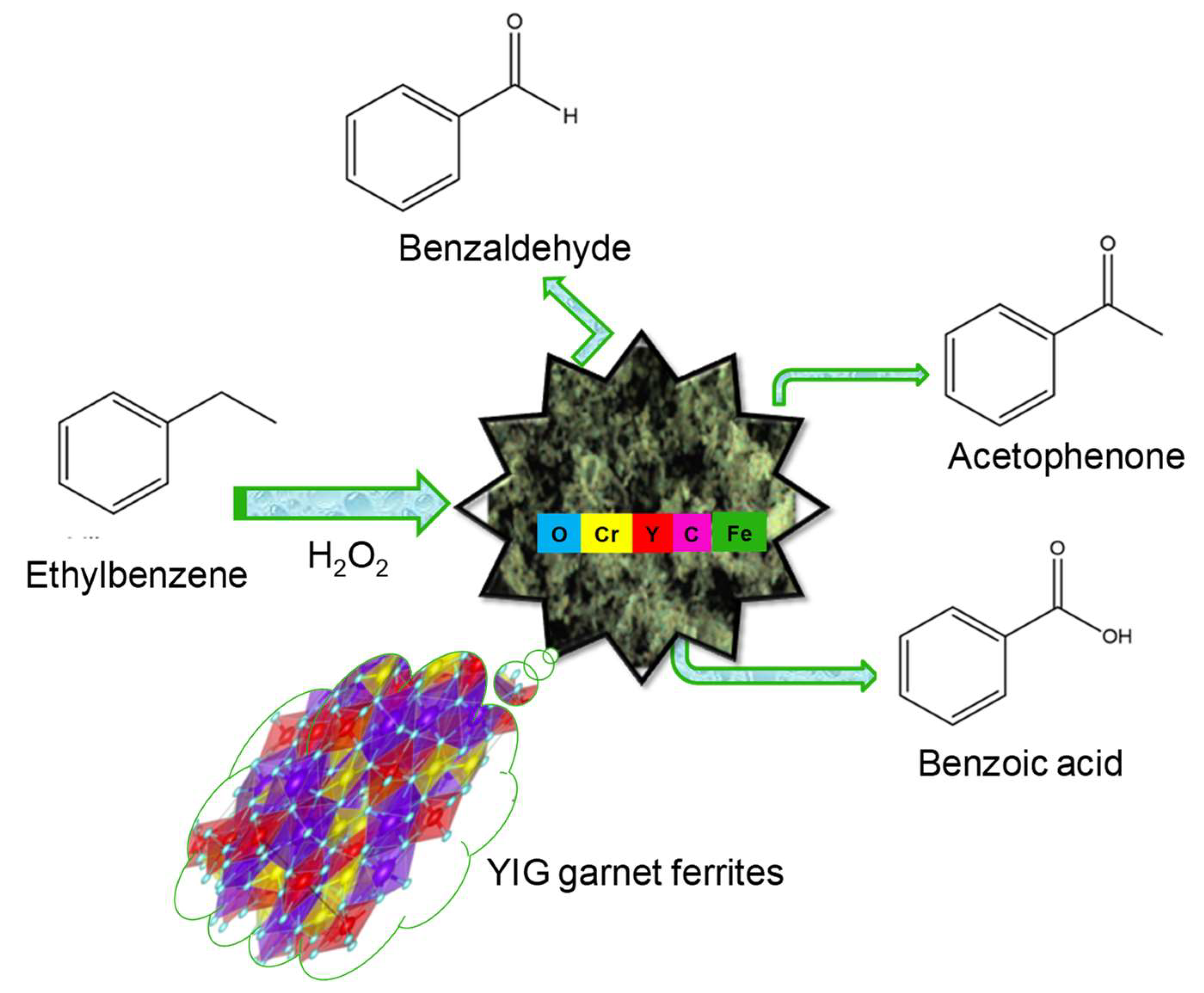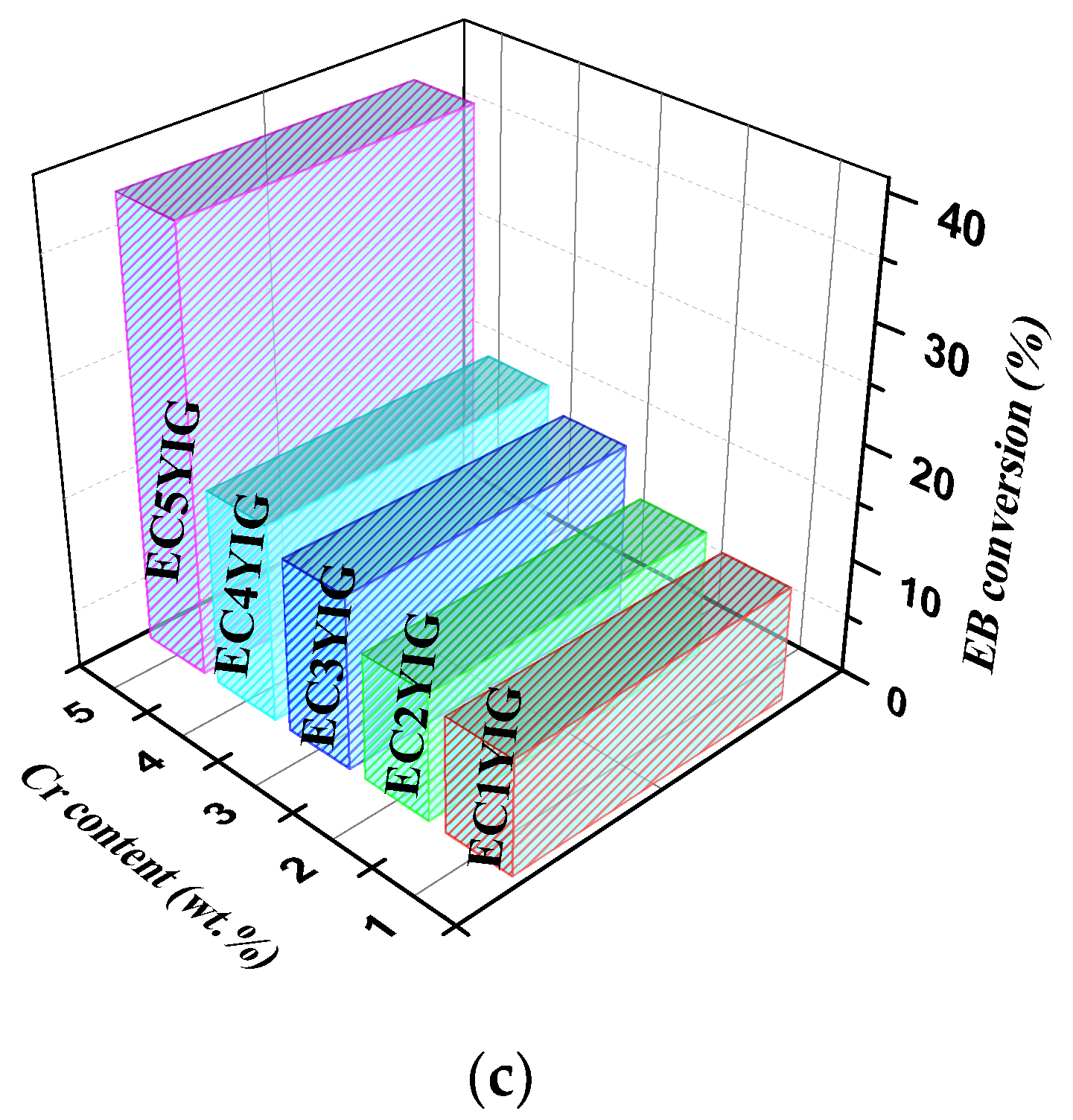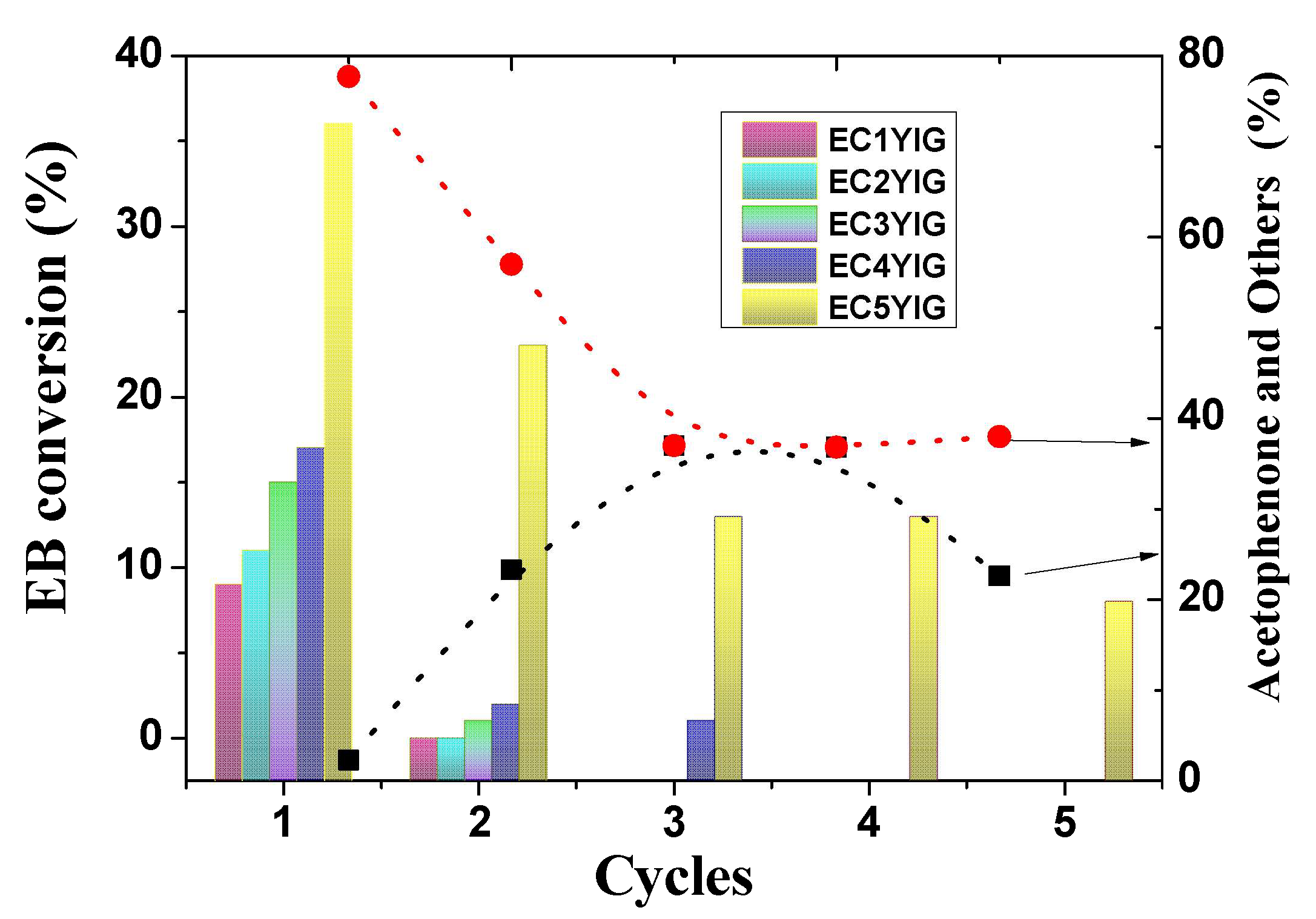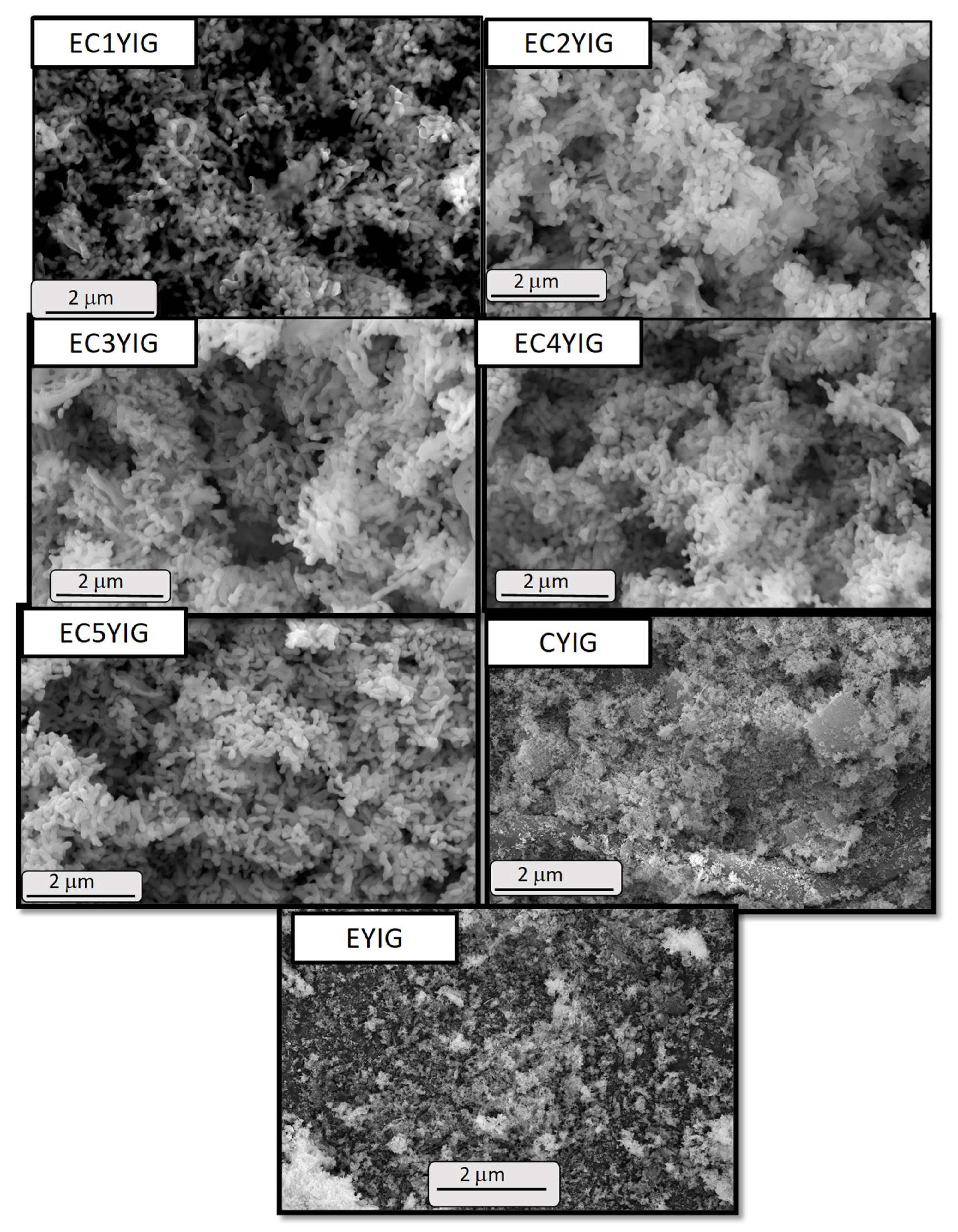Cr-Containing Rare-Earth Substituted Yttrium Iron Garnet Ferrites: Catalytic Properties in the Ethylbenzene Oxidation
Abstract
:1. Introduction
2. Results and Discussion
2.1. Summary of the Main Physiochemical Features of the Fresh YIG Catalysts
2.2. Effect of the Reaction Time on the Catalytic Activity in EB Oxidation with H2O2
2.3. Impact of the Cr Amounts on the Catalytic Activity and Recyclability
2.4. Structure by Raman, FTIR and XRD and Valence States by EPR
2.5. Morphological and Surface Properties
3. Materials and Methods
3.1. Materials
3.2. Synthesis of the YIG Catalyst
3.3. Synthesis of the Er and Cr Containing Yttrium Iron Garnet Ferrites
3.4. Characterizations
3.5. Catalytic Tests
4. Conclusions
Author Contributions
Funding
Data Availability Statement
Acknowledgments
Conflicts of Interest
References
- Norkus, M.; Laurikenas, A.; Vistorskaj, D.; Mazeik, K.; Baltrunas, D.; Skaudzius, R.; Beganskiene, A.; Kareiv, A. Investigation of substitution effects of the first four lanthanides (La, Ce, Pr and Nd) in yttrium iron garnet. J. Alloys Compd. 2022, 903, 163978. [Google Scholar] [CrossRef]
- Leal, L.R.F.; Milani, R.; Oliveira, D.M.; Guerra, Y.; Padrón-Hernández, E.; Franco, A., Jr.; Viana, B.C.; Santos, F.E.P.; Peña-Garcia, R. Competitive effect of dopants on magnetic and structural properties in yttrium iron garnet co-doped with Er and Cr. Ceram. Int. 2020, 46, 18584–18591. [Google Scholar] [CrossRef]
- Guo, Y.; Li, H.; Li, S.; Chen, L.; Li, Z. Study on the Structure, Magnetic Properties and Mechanism of Zn-Doped Yttrium Iron Garnet Nanomaterial Prepared by the Sol-gel Method. Gels 2022, 8, 325. [Google Scholar] [CrossRef]
- Kang, Y.; Han, Y.; Tian, M.; Huang, C.; Wang, C.; Lin, J.; Hou, B.; Su, Y.; Li, L.; Wang, J.; et al. Promoted methane conversion to syngas over Fe-based garnets via chemical looping. Appl. Catal. B Environ. 2020, 278, 119305. [Google Scholar] [CrossRef]
- Carmo, J.V.C.D.; Pinheiro, A.L.G.; Oliveira, A.C.; de Castro, M.O.; Soares, J.M.; Padron-Hernandez, E.; Peña-Garcia, R.; Saraiva, G.D.; Rodríguez-Castellón, E.; Rodríguez-Aguado, E. Comparison of the catalytic performance of YIG garnets and Fe-containing oxides catalysts for oxidation of ethylbenzene. Ceram. Int. 2020, 47, 6279–6289. [Google Scholar] [CrossRef]
- Rajaji, U.; Chinnapaiyan, S.; Chen, S.-M.; Govindasamy, M.; Filho, J.I.O.; Khushaim, W.; Mani, V. Design and Fab-rication of Yttrium Ferrite Garnet-Embedded Graphitic Carbon Nitride: A Sensitive Electrocatalyst for Smartphone-Enabled Point-of-Care Pesticide (Mesotrione) Analysis in Food Samples. ACS Appl. Mater. Interf. 2021, 13, 24865–24876. [Google Scholar]
- Wei, Z.; Yan, W.; Qin, J.; Bi, L. Dysprosium Substituted Ce: YIG Thin Films for Temperature Insensitive Integrated Optical Isolator Applications. Materials 2022, 15, 1691. [Google Scholar]
- Peña-Garcia, R.; Guerra, Y.; Santos, F.; Almeida, L.; Padrón-Hernández, E. Structural and magnetic properties of Ni-doped yttrium iron garnet nanopowders. J. Magn. Magn. Mater. 2019, 492, 165650. [Google Scholar] [CrossRef]
- Musa, M.A.; Azis, R.S.; Osman, N.H.; Hassan, J.; Zangina, T. Structural and magnetic properties of yttrium iron garnet (YIG) and yttrium aluminum iron garnet (YAlG) nanoferrite via sol-gel synthesis. Results Phys. 2017, 7, 1135–1142. [Google Scholar] [CrossRef]
- Leal, R.F.; Guerra, Y.; Padrón-Hernández, E.; Rodrigues, A.R.; Santos, F.E.P.; Peña-Garcia, R. Structural and magnetic properties of yttrium iron garnet nanoparticles doped with copper obtained by sol gel method. Mater. Lett. 2019, 236, 547. [Google Scholar]
- Peña-Garcia, R.; Guerra, Y.; Oliveira, D.; Franco, A.; Padrón-Hernández, E. Local atomic disorder and temperature dependence of saturation magnetization in yttrium iron garnet. Ceram. Int. 2019, 46, 5871–5875. [Google Scholar] [CrossRef]
- Akhtar, M.N.; Yousaf, M.; Khan, S.; Nazir, M.; Ahmad, M.; Khan, M.A. Structural and electromagnetic evaluations of YIG rare earth doped (Gd, Pr, Ho, Yb) nanoferrites for high frequency applications. Ceram. Int. 2017, 43, 17032–17040. [Google Scholar] [CrossRef]
- Hakimia, F.; Fallah-Mehrjardia, M.; Golrasan, E. Yttrium Aluminum Garnet (YAG: Al5Y3O12) as an Efficient Catalyst for the Synthesis of Benzimidazole and Benzoxazole Derivatives. Chem. Methodol. 2020, 4, 234–244. [Google Scholar]
- Cerrato, E.; Gaggero, E.; Calza, P.; Paganini, M.C. The role of Cerium, Europium and Erbium doped TiO2 photocatalysts in water treatment: A mini-review. Chem. Eng. J. Adv. 2022, 10, 100268. [Google Scholar] [CrossRef]
- Lau, Z.Y.; Lee, K.C.; Soleimani, H.; Beh, H.G. Experimental Study of Electromagnetic-Assisted Rare-Earth Doped Yttrium Iron Garnet (YIG) Nanofluids on Wettability and Interfacial Tension Alteration. Energies 2019, 12, 3806. [Google Scholar] [CrossRef]
- Ji, D.; Xi, N.; Li, G.; Dong, P.; Li, H.; Li, H.; Li, C.; Wang, P.; Zhao, Y. Hydrotalcite-based CoxNiyAl1Ox mixed oxide as a highly efficient catalyst for selective ethylbenzene oxidation. Mol. Catal. 2021, 508, 111579. [Google Scholar] [CrossRef]
- Zhao, H.; Fang, J.; Xu, D.; Li, J.; Li, B.; Zhao, H.; Dong, Z. Multistep protection strategy for preparation of atomically dispersed Fe–N catalysts for selective oxidation of ethylbenzene to acetophenone. Catal. Sci. Technol. 2022, 12, 641–651. [Google Scholar] [CrossRef]
- Liu, H.; Li, G.; Hu, C. Selective ring C-H bonds activation of toluene over Fe/activated carbon catalyst. J. Mol. Catal. A Chem. 2013, 377, 143–153. [Google Scholar] [CrossRef]
- Pinheiro, A.L.G.; Oliveira, A.P.S.; De Sousa, F.F.; Soares, J.M.; Saraiva, G.D.; Oliveira, A.C.; Lang, R. CeFe-Based Bead Nanocomposites as Catalysts for Oxidation of Ethylbenzene Reaction. Catalysts 2018, 8, 495. [Google Scholar] [CrossRef]
- Ramu, R.; Hail, W.; Wann, M.; Janmanchi, D.; Tsai, Y.-F.; Liu, C.-C.; Mou, C.-Y.; Yu, S.S.-F. Mechanistic study for the selective oxidation of benzene and toluene catalyzed by Fe(ClO4)2 in an H2O2-H2O-CH3CN system. Mol. Catal. 2017, 441, 114–121. [Google Scholar] [CrossRef]
- Neto, A.D.B.S.; Pinheiro, L.G.; Filho, J.M.; Oliveira, A. Studies on styrene selective oxidation over iron-based catalysts: Reaction parameters effects. Fuel 2015, 150, 305–317. [Google Scholar] [CrossRef]
- Oliveira, A.P.S.; Gomes, I.S.; Neto, A.S.; Oliveira, A.C.; Filho, J.M.; Saraiva, G.D.; Soares, J.M.; Tehuacanero-Cuapa, S. Catalytic performance of MnFeSi composite in selective oxidation of styrene, ethylbenzene and benzyl alcohol. Mol. Catal. 2017, 436, 29–42. [Google Scholar] [CrossRef]
- Tavallaei, H.; Jafarpour, M.; Feizpour, F.; Rezaeifard, A.; Farrokhi, A. A Cooperative Effect in a Novel Bimetallic Mo–V Nanocomplex Catalyzed Selective Aerobic C–H Oxidation. ACS Omega 2019, 4, 3601–3610. [Google Scholar] [CrossRef]
- Habibi, D.; Faraji, A.; Arshadi, M.; Fierro, J. Characterization and catalytic activity of a novel Fe nano-catalyst as efficient heterogeneous catalyst for selective oxidation of ethylbenzene, cyclohexene, and benzylalcohol. J. Mol. Catal. A Chem. 2013, 372, 90–99. [Google Scholar] [CrossRef]
- Pardeshi, S.K.; Pawar, R.Y. SrFe2O4 complex oxide an effective and environmentally benign catalyst for selective oxi-dation of styrene. J. Mol. Catal. A Chem. 2011, 334, 35–43. [Google Scholar] [CrossRef]
- Hachemaoui, M.; Molina, C.; Belver, C.; Bedia, J.; Mokhtar, A.; Hamacha, R.; Boukoussa, B. Metal-Loaded Mesoporous MCM-41 for the Catalytic Wet Peroxide Oxidation (CWPO) of Acetaminophen. Catalysts 2021, 11, 219. [Google Scholar] [CrossRef]
- Kholdeeva, O.; Skobelev, I.Y.; Ivanchikova, I.D.; Kovalenko, K.A. Hydrocarbon oxidation over Fe- and Cr-containing metal-organic frameworks MIL-100 and MIL-101–a comparative study. Catal. Today 2014, 238, 54–61. [Google Scholar] [CrossRef]
- Batista, A.H.M.; Sousa, F.F.; Honorato, S.B.; Ayala, A.P.; Filho, J.M.; Sousa, F.W.; Pinheiro, A.N.; Araujo, J.C.S.; Nas-Cimento, R.F.; Valentini, A.; et al. Ethylbenzene to chemicals: Catalytic conversion of ethylbenzene into styrene over metal-containing MCM-41. J. Mol. Catal. A Chem. 2010, 315, 86–98. [Google Scholar] [CrossRef]
- Gutmann, B.; Elsner, P.; Roberge, D.; Kappe, C.O. Homogeneous Liquid-Phase Oxidation of Ethylbenzene to Aceto-phenone in Continuous Flow Mode. ACS Catal. 2013, 3, 2669–2676. [Google Scholar] [CrossRef]
- Bansal, V.K.; Thankachan, P.P.; Prasad, R. Oxidation of benzyl alcohol and styrene using H2O2 catalyzed by tetraazamacrocycle complexes of Cu(II) and Ni(II) encapsulated in zeolite-Y. Appl. Catal. A Gen. 2010, 381, 8–17. [Google Scholar] [CrossRef]
- Annatha, H.; Manayil, J.C.; Thompson, J.; Marra, A.C.; Raja, R. Contrasting structure-property relationships in amorphous, hierarchical and microporous aluminophosphate catalysts for Claisen-Schmidt condensation reactions. Appl. Catal. A Gen. 2021, 627, 118376. [Google Scholar] [CrossRef]
- Aarinol, C.; Dimakatso, A.; Maheso, J.; Bingwa, N.; Meijboom, R. Highly tunable selectivity to benzaldehyde over Pd/ZrO2 catalysts in Oppenauer oxidation of benzyl alcohol using acetone as H-acceptor. Appl. Catal. A Gen. 2021, 61, 118022. [Google Scholar]
- Tamizhdurai, P.; Narayanan, S.; Kumaran, R.; Mangesh, V.L.; Kavitha, C.; Lakshmi, N.V.; Ragupathi, C.; ALOthman, Z.A.; Ouladsman, M.; Manie, G. Catalytic activity of ratio-dependent SBA-15 supported cerium/Pt catalysts for highly selective oxidation reaction of benzyl alcohol to benzaldehyde. Adv. Powder Technol. 2021, 32, 4286–4294. [Google Scholar] [CrossRef]
- Borade, R.B.; Shirsath, S.E.; Vats, G.; Gaikwad, A.S.; Patange, S.M.; Kadam, S.B.; Kadam, R.H.; Kadam, A.B. Poly-crystalline to preferred-(100) single crystal texture phase transformation of yttrium iron garnet nanoparticles. Nanoscale Adv. 2019, 1, 403–413. [Google Scholar] [CrossRef]
- Caland, J.; Medrano, C.P.; Caytuero, A.; Baggio-Saitovitch, E.; Litterst, F.; Soares, J.M.; Cabrera-Baez, M.; Padrón-Hernández, E.; Marques, T.; Guerra, Y.; et al. Preferential site occupancy of Ni ions and oxidation state of Fe ions in the YIG crystal structure obtained by sol-gel method. J. Alloys Compd. 2020, 849, 156657. [Google Scholar] [CrossRef]
- Sharma, V.; Kuanr, B.K. Magnetic and crystallographic properties of rare-earth substituted yttrium-iron garnet. J. Alloys Compd. 2018, 748, 591–600. [Google Scholar] [CrossRef]
- Wu, D.; Liu, X.; Han, Y.; Kan, X.; Feng, S.; Lv, Q.; Yang, Y.; Li, Y.; Liu, C. Investigation of the structural and magnetic properties of Y2.8Ca0.2Fe5-Al M O12 (M = Mn and Cr, x = y + z). J. Magn. Magn. Mater. 2022, 556, 169291. [Google Scholar] [CrossRef]
- Arsenova, H.; Bludau, N.; Haag, W.O.; Karge, H.G. In situ IR spectroscopic study of the adsorption behaviour of ethylbenzene and diethylbenzenes related to ethylbenzene disproportionation over HY zeolite. Microporous Mesoporous Mater. 1988, 23, 1–10. [Google Scholar] [CrossRef]
- Zhang, W.; Guo, C.; Ji, R.; Fang, C.; Zeng, Y. Low-temperature synthesis and microstructure-property study of single-phase yttrium iron garnet (YIG) nanocrystals via a rapid chemical coprecipitation. Mater. Chem. Phys. 2011, 125, 646–651. [Google Scholar] [CrossRef]
- Fujita, S.-I.; Onodera, Y.; Yoshida, H.; Arai, M. Selective hydrogenation of acetophenone with supported Pd and Rh catalysts in water, organic solvents, and CO2-dissolved expanded liquids. Green Chem. 2016, 18, 4934–4940. [Google Scholar] [CrossRef]
- Wu, P.; Song, L.; Wang, Y.; Liu, X.; He, Z.; Bai, P.; Yan, Z. High-performance benzyl alcohol oxidation catalyst: Au-Pd alloy with ZrO2 as promoter. Appl. Surf. Sci. 2020, 537, 148059. [Google Scholar] [CrossRef]
- Joseph, Y.; Niklewski, M.; Wuhn, A.; Ranke, M.W.; Weiss, W.; Woll, C.; Schologl, R. Interaction of ethylbenzene and styrene with iron oxide model catalyst at low coverages: A NEXAFS study. Phys. Chem. Chem. Phys. 2000, 2, 5314–5319. [Google Scholar] [CrossRef]
- Sun, X.; Lv, D.; Chen, Y.; Wu, Y.; Wu, Q.; Xia, Q.; Li, Z. Enhanced Adsorption Performance of Aromatics on a Novel Chromium-Based MIL-101@Graphite Oxide Composite. Energy Fuels 2017, 31, 13985–13990. [Google Scholar] [CrossRef]
- Momma, K.; Izumi, F. VESTA 3 for three-dimensional visualization of crystal, volumetric and morphology data. J. Appl. Crystallogr. 2011, 44, 1272–1276. [Google Scholar] [CrossRef]
- Ren, Y.; Yao, H.; Hu, J.; Cao, G.; Ji, J.; Tian, J.; Pan, J. Evolution of “Spinodal decomposition”-like structures during the oxidation of Zr(Fe,Nb)2 under subcritical environment. Scr. Mater. 2010, 187, 107–112. [Google Scholar] [CrossRef]
- Wu, K.; Yao, H.; Cheng, X.; Hu, J.; Cao, G.; Yuan, G. Oxidation behavior and chemical evolution of architecturally arranged Zr/Si multilayer at high temperature. Surf. Coat. Technol. 2020, 399, 126205. [Google Scholar] [CrossRef]
- Knapp, M.J.; Krzystek, J.; Brunel, L.-C.; Hendrickson, D.N. High-Frequency EPR Study of the Ferrous Ion in the Reduced Rubredoxin Model [Fe(SPh)4]2−. Inorg. Chem. 2000, 39, 107–112. [Google Scholar] [CrossRef]
- Sáez, M.R.; Divakar, D.; Aranzabal, A.; González-Velasco, J.R.; Marcos, J.A.G. Catalytic oxidation of trichloroethylene over Fe-ZSM-5: Influence of the preparation method on the iron species and the catalytic behavior. Appl. Catal. B Environ. 2015, 180, 210–218. [Google Scholar] [CrossRef]
- Singh, G.; Ram, S. Optical and electron paramagnetic resonance properties of native Cr2O3 surface over CrO2. J. Magn. Magn. Mater. 2010, 322, 1484–1487. [Google Scholar] [CrossRef]
- Elhamali, M.; Ibrahim, N.B.; Radiman, S. Oxygen vacancy-dependent microstructural, optical and magnetic properties of sol-gel Tb0.2Er1Y2.8Fe5O12 films. J. Magn. Magn. Mater. 2000, 497, 166048. [Google Scholar] [CrossRef]
- Cao, Z.; Zuo, C. Cr2O3/carbon nanosheet composite with enhanced performance for lithium ion batteries. RSC Adv. 2017, 7, 40243. [Google Scholar] [CrossRef]
- Kumar, P.; Sharma, V.; Sarwab, A.; Kumar, A.; Surbhi; Goyal, R.; Sachdev, K.; Annapoornic, S.; Asokan, K.; Kanjilal, D. Understanding the origin of ferromagnetism in Er-doped ZnO system. RSC Adv. 2016, 6, 89242–89249. [Google Scholar] [CrossRef]
- Oliveira, A.P.S.; Gomes, I.S.; Oliveira, A.C.; Filho, J.M.; Saraiva, G.D.; Soares, J.M.; Sousa, F.F.; Campos, A. Styrene Oxi-dation to Valuable Compounds over Nanosized FeCo-Based Catalysts: Effect of the Third Metal Addition. Catalysts 2017, 7, 323. [Google Scholar] [CrossRef]
- Song, W.; Li, S.; Zhai, S.-R.; An, Q.-D.; Li, M.-H.; Song, Y.; Song, X.-W. Designed synthesis of multifunctional Fe3O4@SiO2–NH2@CS–Co(II) towards efficient oxidation of ethylbenzene. Mater. Res. Bull. 2014, 60, 665–673. [Google Scholar]
- Luo, L.; Liu, H.; Li, G.; Hu, C. Partial oxidation of ethylbenzene by H2O2 on VOx/HZSM-22 catalyst. RSC Adv. 2016, 6, 55463. [Google Scholar] [CrossRef]












| Catalyst | a Composition | b Crystal Structure | b Crystal Sizes (nm) |
|---|---|---|---|
| YIG | Y3Fe5O12 | YIG | 53 |
| EYIG | Y2.98Fe5Er0.02O12 | YIG | 57 |
| CYIG | Y2.98Fe4.98Cr0.02O12 | YIG | 65 |
| EC1YIG | Y2.98Fe4.99Er0.02Cr0.01O12 | YIG | 53 |
| EC2YIG | Y2.98Fe4.98Er0.02Cr0.02O12 | YIG | 64 |
| EC3YIG | Y2.98Fe4.97Er0.02Cr0.03O12 | YIG | 63 |
| EC4YIG | Y2.98Fe4.96Er0.02Cr0.04O12 | YIG | 67 |
| EC5YIG | Y2.98Fe4.95Er0.02Cr0.05O12 | YIG | 58 |
| (%) Selectivity to the Products | ||||
|---|---|---|---|---|
| Catalyst | Acetophenone | Benzaldehyde | Benzoic Acid | Others |
| YIG | 22.3 | - | - | 77.7 |
| EC1YIG | 38.0 | 3.8 | 6.6 | 51.6 |
| EC2YIG | 36.4 | 2.7 | 4.3 | 56.6 |
| EC3YIG | 23.3 | - | 49.3 | 27.4 |
| EC4YIG | 13.8 | - | 49.4 | 36.8 |
| EC5YIG | 2.3 | - | 29.8 | 67.9 |
| Sample | Fe 2p (eV) | Y 3d (eV) | Cr 2p (eV) | O 1s (eV) | C 1s (eV) | Y/Fe | Cr/C |
|---|---|---|---|---|---|---|---|
| CYIG | 710.6 725.4 | 157.1 159.1 | 576.4 587.5 | 529.7 531.4 532.9 | 284.5 285.8 288.2 | 1.56 | 0.03 |
| EC1YIG | 710.4 725.4 | 157.2 159.2 | 576.8 586.6 | 529.7 531.2 532.8 | 284.6 286.1 288.4 | 1.06 | 0.05 |
| EC2YIG | 710.6 725.4 | 157.3 159.4 | 577.0 587.1 | 529.9 531.5 532.8 | 284.7 285.9 288.4 | 1.02 | 0.03 |
| EC3YIG | 710.5 725.4 | 157.4 159.5 | 577.2 587.5 | 529.9 531.4 532.8 | 284.8 286.1 288.5 | 1.16 | 0.03 |
| EC4YIG | 710.9 725.4 | 157.6 159.6 | 577.2 587.6 | 529.9 531.4 532.8 | 284.7 285.9 288.4 | 1.27 | 0.02 |
| EC5YIG | 710.5 725.4 | 157.4 159.4 | 576.9 587.4 | 529.9 531.5 532.8 | 284.8 286.2 288.6 | 1.25 | 0.04 |
Publisher’s Note: MDPI stays neutral with regard to jurisdictional claims in published maps and institutional affiliations. |
© 2022 by the authors. Licensee MDPI, Basel, Switzerland. This article is an open access article distributed under the terms and conditions of the Creative Commons Attribution (CC BY) license (https://creativecommons.org/licenses/by/4.0/).
Share and Cite
do Carmo, J.V.C.; de Cássia F. Bezerra, R.; Guerra, Y.; Peña-Garcia, R.; Oliveira, A.C.; Padron-Hernandez, E.; Saraiva, G.D.; Soares, J.M.; Castro, A.J.R.; Tehuacanaero-Cuapa, S.; et al. Cr-Containing Rare-Earth Substituted Yttrium Iron Garnet Ferrites: Catalytic Properties in the Ethylbenzene Oxidation. Catalysts 2022, 12, 1033. https://doi.org/10.3390/catal12091033
do Carmo JVC, de Cássia F. Bezerra R, Guerra Y, Peña-Garcia R, Oliveira AC, Padron-Hernandez E, Saraiva GD, Soares JM, Castro AJR, Tehuacanaero-Cuapa S, et al. Cr-Containing Rare-Earth Substituted Yttrium Iron Garnet Ferrites: Catalytic Properties in the Ethylbenzene Oxidation. Catalysts. 2022; 12(9):1033. https://doi.org/10.3390/catal12091033
Chicago/Turabian Styledo Carmo, José Vitor C., Rita de Cássia F. Bezerra, Y. Guerra, R. Peña-Garcia, Alcineia C. Oliveira, E. Padron-Hernandez, Gilberto D. Saraiva, João M. Soares, Antonio Joel R. Castro, Samuel Tehuacanaero-Cuapa, and et al. 2022. "Cr-Containing Rare-Earth Substituted Yttrium Iron Garnet Ferrites: Catalytic Properties in the Ethylbenzene Oxidation" Catalysts 12, no. 9: 1033. https://doi.org/10.3390/catal12091033
APA Styledo Carmo, J. V. C., de Cássia F. Bezerra, R., Guerra, Y., Peña-Garcia, R., Oliveira, A. C., Padron-Hernandez, E., Saraiva, G. D., Soares, J. M., Castro, A. J. R., Tehuacanaero-Cuapa, S., Rodríguez-Aguado, E., & Rodríguez-Castellón, E. (2022). Cr-Containing Rare-Earth Substituted Yttrium Iron Garnet Ferrites: Catalytic Properties in the Ethylbenzene Oxidation. Catalysts, 12(9), 1033. https://doi.org/10.3390/catal12091033









